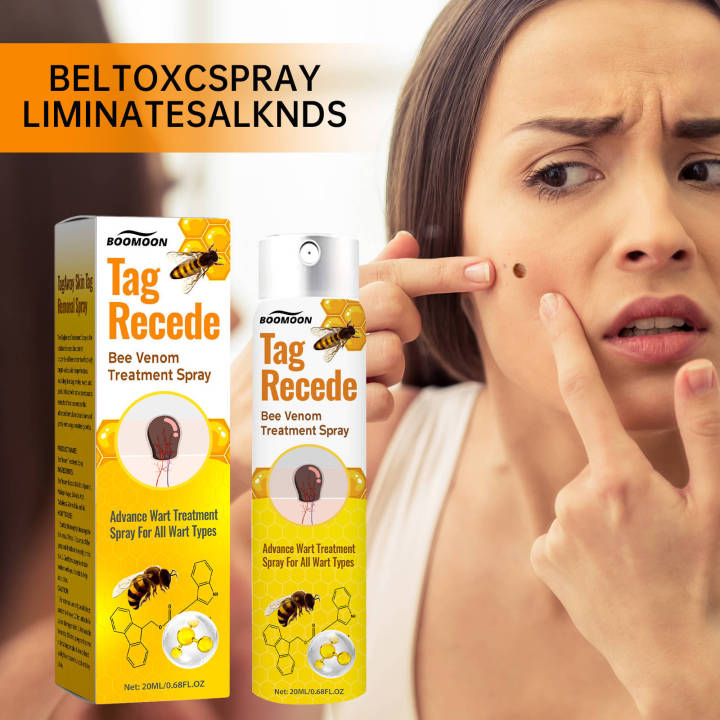Bee Venom Benefits For Skin Tags

Skin tags, those small, benign growths that often appear on the neck, armpits, and eyelids, are a common nuisance affecting millions worldwide. While generally harmless, their presence can be bothersome, leading many to seek effective removal methods. Now, emerging research suggests an unexpected source for potential skin tag treatment: bee venom.
The buzz surrounding bee venom as a cosmetic ingredient is growing. This article delves into the science behind bee venom's purported benefits for skin tags, exploring the evidence, potential risks, and expert opinions surrounding this intriguing, albeit unconventional, approach.
What is Bee Venom and How Might it Work?
Bee venom, or apitoxin, is a complex mixture of enzymes, peptides, and amino acids produced by honeybees. Its primary component, melittin, possesses potent anti-inflammatory and pain-relieving properties. It also contains compounds like apamin and phospholipase A2, which contribute to its biological activity.
The proposed mechanism behind bee venom's effect on skin tags centers on its ability to stimulate the body's own healing processes. Some researchers suggest that bee venom could trigger a localized inflammatory response, leading to the breakdown of the skin tag's tissue.
Furthermore, the enzymatic activity of bee venom might contribute to the denaturation of proteins within the skin tag, further facilitating its disintegration.
The Science Behind Bee Venom and Skin Tags: Examining the Evidence
Currently, direct scientific evidence specifically investigating the use of bee venom for skin tag removal is limited. Much of the information available is anecdotal or derived from studies focused on bee venom's broader dermatological applications.
One small study published in the Journal of Dermatological Science explored the effects of bee venom on skin cell proliferation. While the study didn't focus on skin tags, it showed that bee venom could influence cell growth and differentiation, suggesting a potential mechanism for tissue remodeling.
However, it is important to emphasize that more robust clinical trials are needed to determine the efficacy and safety of bee venom specifically for skin tag removal.
Expert Opinions and Perspectives
Dermatologists remain cautious about endorsing bee venom as a primary treatment for skin tags. "While bee venom shows promise in certain dermatological applications, its use for skin tags is still experimental," explains Dr. Anya Sharma, a board-certified dermatologist at the Skin Health Institute.
"The risk of allergic reactions and potential skin irritation warrants careful consideration. Proven methods like cryotherapy, surgical excision, and electrocautery remain the gold standard for skin tag removal," adds Dr. Sharma.
Alternative medicine practitioners, on the other hand, sometimes view bee venom as a natural alternative. They argue that its anti-inflammatory properties and potential to stimulate the immune system could promote skin tag resolution.
"Bee venom has been used for centuries for various medicinal purposes," says Maria Rodriguez, a licensed acupuncturist and bee venom therapist. "When applied topically in a controlled manner, it can potentially help reduce the size and appearance of skin tags. However, it's crucial to work with a qualified practitioner and be aware of potential allergic reactions."
Potential Risks and Side Effects
The most significant risk associated with bee venom is the potential for allergic reactions. Some individuals are highly allergic to bee venom, and even a small amount can trigger a severe, life-threatening reaction known as anaphylaxis.
Symptoms of an allergic reaction can include hives, swelling, difficulty breathing, and loss of consciousness. Anyone considering bee venom should undergo allergy testing beforehand.
Other potential side effects of bee venom application include skin irritation, redness, itching, and pain. These side effects are usually mild and temporary but can be uncomfortable.
Safe and Effective Alternatives for Skin Tag Removal
Several established and safe methods exist for removing skin tags. These include cryotherapy (freezing with liquid nitrogen), surgical excision (cutting off the skin tag with a scalpel), and electrocautery (burning off the skin tag with an electric current).
These procedures are typically performed by a dermatologist or other qualified medical professional. They are generally quick, effective, and associated with minimal discomfort.
Over-the-counter products, such as medicated creams and freezing kits, are also available. However, it's crucial to consult with a dermatologist before using these products, as they may not be suitable for all skin types or skin tag locations.
The Future of Bee Venom in Dermatology
While the current evidence supporting the use of bee venom for skin tag removal is limited, ongoing research continues to explore its potential dermatological applications. Studies are investigating its efficacy in treating conditions like acne, psoriasis, and wrinkles.
If future research demonstrates the safety and effectiveness of bee venom for skin tag removal, it could become a viable alternative treatment option. However, rigorous clinical trials are essential to validate these claims.
For now, individuals seeking skin tag removal should rely on established methods recommended by their dermatologists. The allure of natural remedies like bee venom is undeniable, but prioritizing safety and evidence-based treatments is paramount. More research is needed to unlock the full potential – and understand the risks – of bee venom in treating skin conditions like skin tags.


















